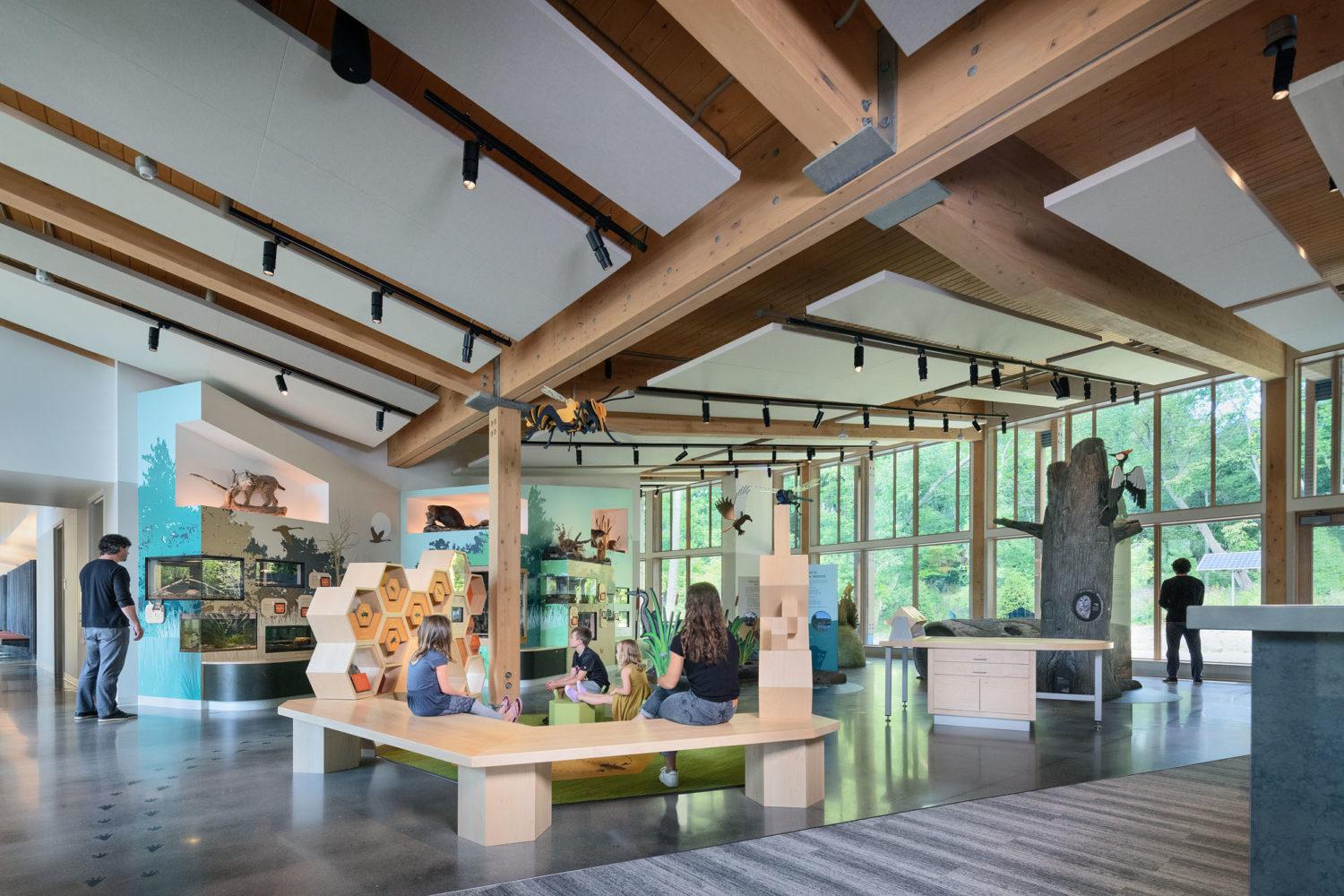The Westwood Hills Nature Center in St. Louis Park, Minnesota recently achieved Zero Energy Certification from the International Living Future Institute (ILFI).
The Center is part of a 160-acre nature park featuring prairie, forest, and marsh areas in the heart of the city. Working closely with the City of St. Louis Park and other partners, HGA designed a Zero Energy building to serve as a teaching tool, demonstrating passive and active strategies for energy efficiency and stormwater management, in addition to showcasing interpretive exhibits highlighting Minnesota’s landscape and wildlife habitat. One hundred percent of the Center’s annual energy needs are supplied by on-site renewable energy.
According to ILFI, “Zero energy is recognized worldwide as one of the highest aspirations in energy performance in the built environment. Zero Energy Certification allows projects to demonstrate that the building is truly operating as claimed, harnessing energy from the sun, wind, or earth to produce net annual energy demand. Through a third-party audit of actual performance data, Zero Energy certified projects are proven to be highly efficient buildings that rely only on clean energy, without onsite combustion of fossil fuels.”
This recent certification reflects the City of St. Louis Park’s long legacy of environmental stewardship and highlights HGA’s commitment to meeting clients’ goals through a holistic approach, integrating sustainability, resilience, research, and equity into the design process.
Resilience and Future Climate Projections
Initially, HGA worked with the City and local government officials to explore how future climate conditions could impact building system performance and Zero Energy operations.
The use of climate projection data played a key role in verifying the performance of building systems well into the future. Early on, HGA and owner representatives held a resilience workshop to assess potential risks to the project over its life span including everything from public safety scenarios to impacts of climate change. From an energy standpoint, the team used multiple projected data sets from WeatherShift in the energy model to compare system performance under different climate scenarios. Minnesota’s cold climate is projected to warm, so heating loads were shown to decrease and cooling loads to increase, resulting in an overall predicted decrease in overall energy use in both the best case and worst-case future warming scenarios.
Ariane Laxo, HGA Director of Sustainability, said, “The client wanted this building to be a teaching tool, demonstrating sustainable design throughout the project as part of their conservation programming. The design team was collaborative across disciplines, and sustainability strategies literally shaped the building, from passive design strategies contributing to the net zero energy goal to natural, biophilic materials selected to foster a connection to nature and lower the project’s embodied carbon. The resulting space is beautiful, inspiring, and blends seamlessly into the surrounding natural environment.”

Net Zero Energy Engineering
Great strides have been made in delivering energy-efficient and net zero energy buildings throughout the industry. However, aggressive energy-efficient building design still poses challenges in colder climates like Minnesota. The design team and the owner felt it was important to deliver a proven and cost-effective way to achieve Net Zero Energy building design. Through the integrated development of the building form and passive energy reduction strategies, a high-performance envelope, advanced lighting, and effective use of proven heat pump technologies, the Westwood Hills Nature Center was able to achieve cost-effective Zero Energy Certification, eliminating the use of fossil fuels in its operation. Since its opening, the building design and energy-efficient systems have already served as an important educational piece to the region and the public.
Notable facts about Westwood Hills Nature Center:
- The Nature Center is an all-electric and fossil-fuel free building.
- The Center is Zero Energy Certified.
- Operational data shows the building as energy net positive. This means that on an annual basis, it produces more energy than it consumes.
- Westwood Hills Nature Center and the Wolf Ridge Environmental Center in Finland, Minnesota, both designed by integrated HGA teams, are the two largest Zero Energy Certified buildings in Minnesota, of only three total in the state.

Westwood Hills Nature Center is the winner of the following awards:
- The Architectural Engineering Institute of the American Society of Civil Engineers Professional Project Award 2021
- 2020 AIA Minnesota Honor Award
- 2021 National Recreation and Park Association, Innovation in Park Design Award
- 2021 AIA San Francisco Architecture Merit Award
- 2021 ASHRAE Region VI Technology Awards 1st Place Public Assembly New Category 2021 League of Minnesota Cities/Green Step Cities Sustainable City Award
Project partners include RJM Construction as the general contractor, Integral on energy modeling and zero energy strategy, and Salter on acoustics.
Learn more about HGA’s sustainable design services here.
